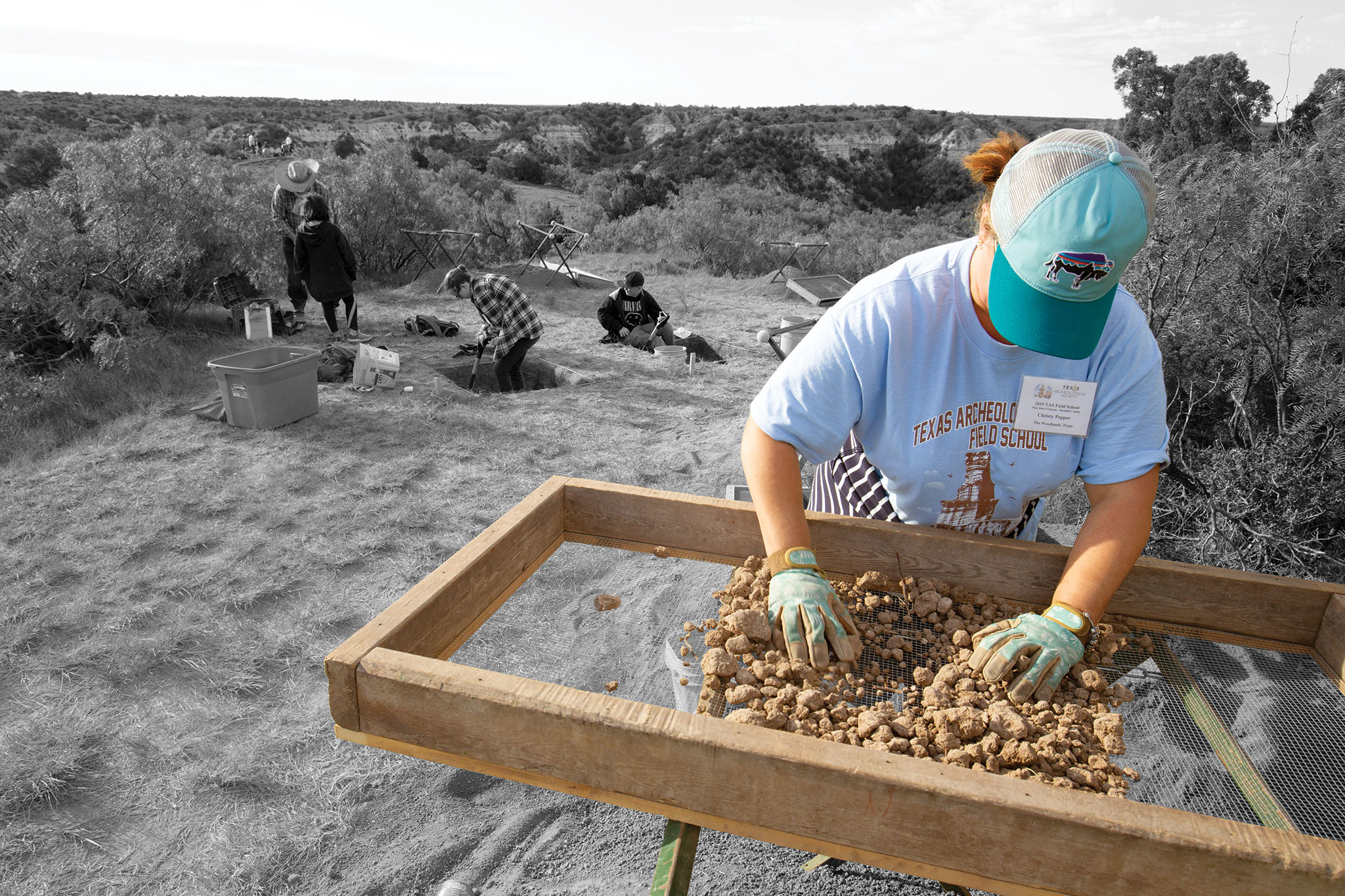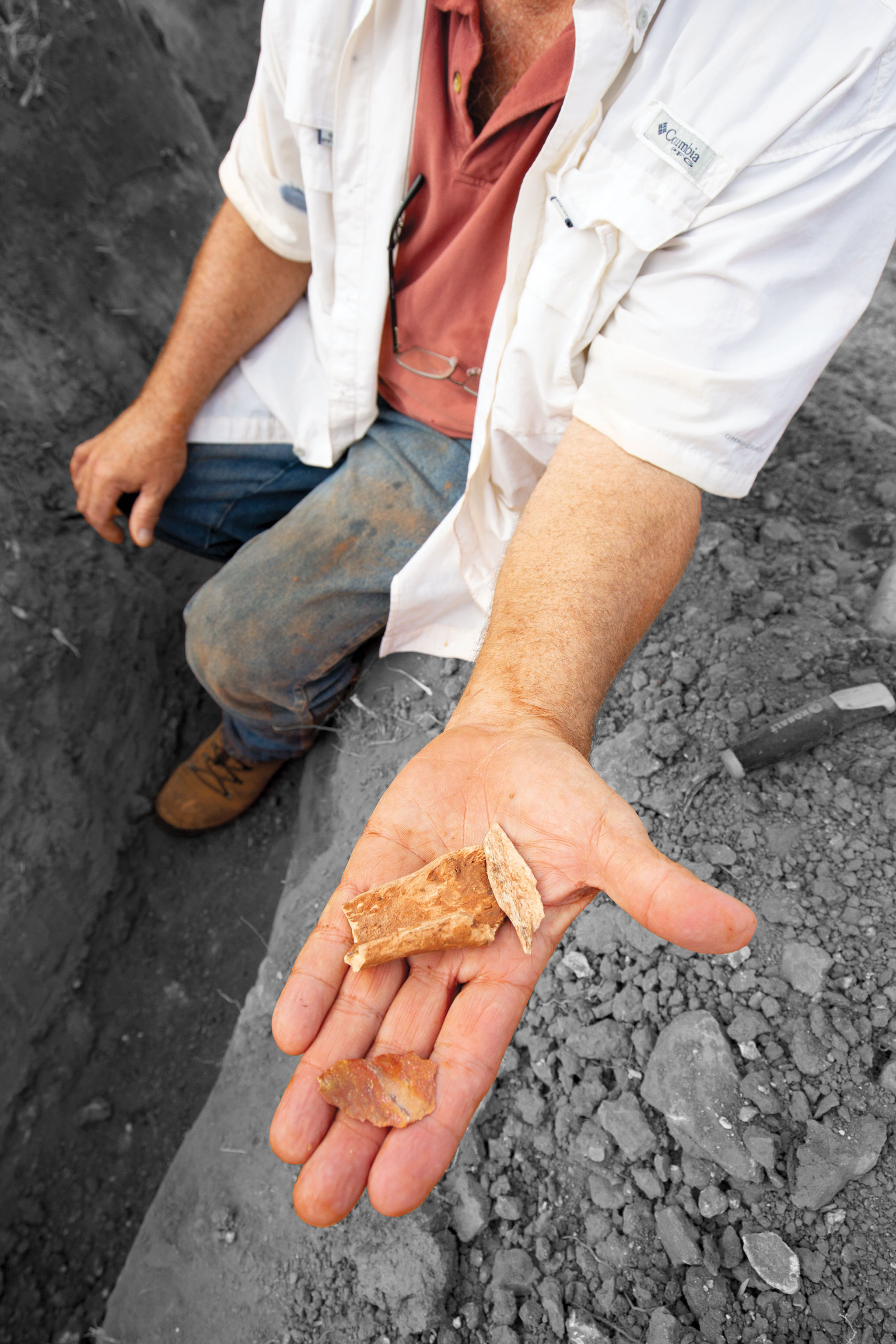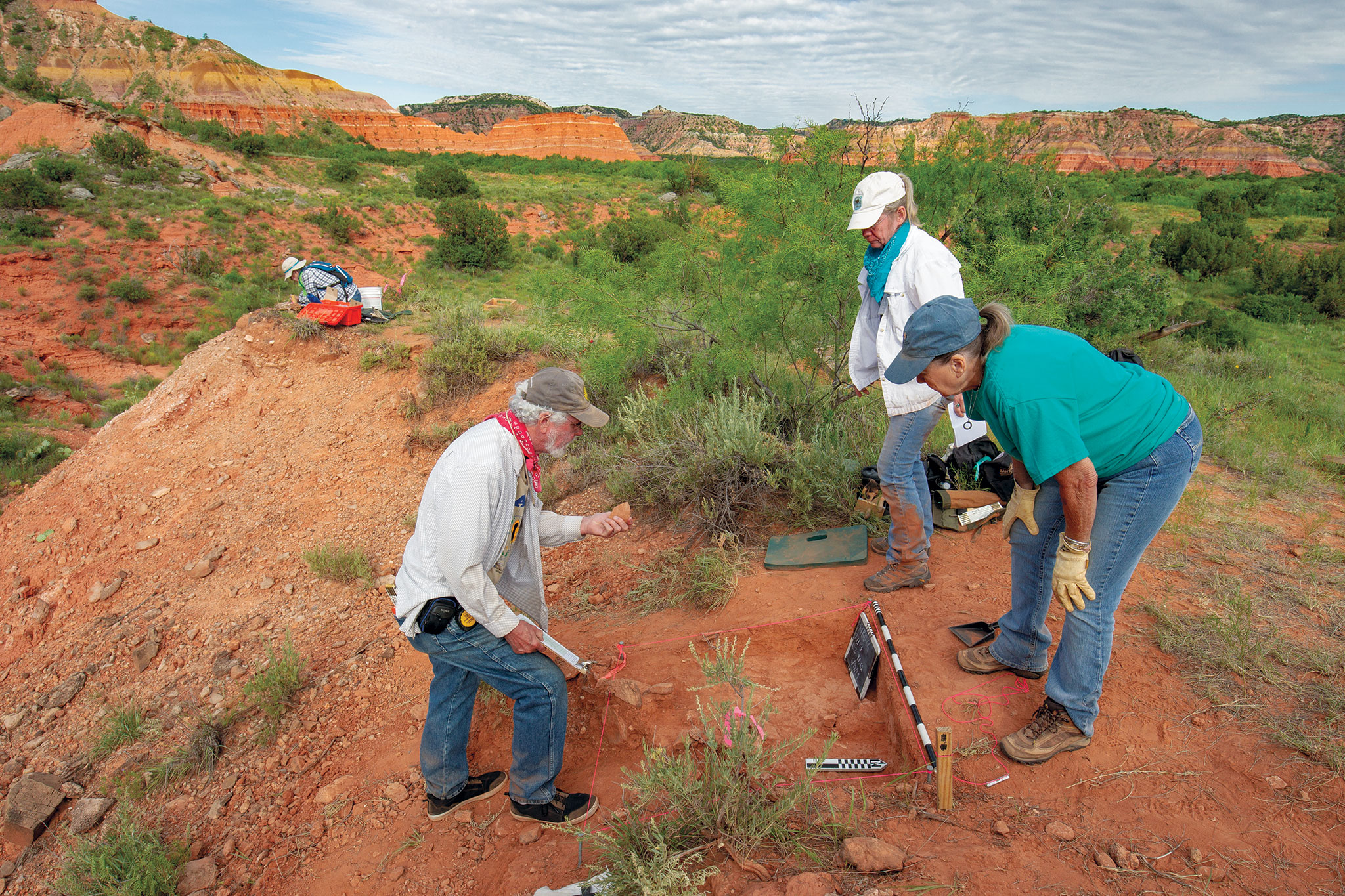
Boots on the Ground, Hands in the Dirt
Archeological field school uncovers the past at Palo Duro Canyon.
Story by Kathryn Hunter • Photos by Earl Nottingham
The shortgrass prairie of the Texas Panhandle, with its unbroken horizon, is like the bottom of the ocean; the endless blue sky above is the water. Then that smooth, exposed seafloor falls away into the depths of a magical, rust-red canyonland where crumbling walls are laced with veins of sparkling white gypsum, boulders perch on thin columns of soil like castle spires, and quiet rivers flow beneath the shade of cottonwood trees. Palo Duro Canyon, a sanctuary of the ages, holds the secrets of thousands of years of human habitation.
In June, as first-time participants of the Texas Archeological Society Field School, my husband Jack and I discover that rich past in a boots-on-the-ground, eight-day research and training program.
WHY WE'RE HERE
Walking into Palo Duro’s Mack Dick Pavilion, TAS headquarters for the week, is like stumbling into the middle of a family reunion. The TAS has held an annual field school in varying locations since 1962. Many of the 342 people here — an eclectic mix of professional archeologists and hobbyists, all volunteers — have been coming for years, some for decades.
Tony Lyle, Texas Parks and Wildlife Department cultural resources coordinator and TAS member, has brought his family for the first time to participate.
“My wife and daughters have seen me go, and I tell them stories they don’t really understand,” Tony says. “They think I’m just camping and doing archeology all day, but now they’ve seen all this.” He points out the camaraderie, the connections.
In what he calls a “once-in-a-lifetime thing,” Tony is heading up the field school’s operations alongside principal investigator Kevin Hanselka, a Texas Department of Transportation archeologist here in a volunteer capacity. Kevin applied for and received the Texas Antiquities Permit required by law for archeological projects on public land from the Texas Historical Commission.
Most TAS field schools are held on private land. The field school at Palo Duro Canyon State Park, like the last on public land in 2012 at Devils River State Natural Area, is focused largely on pedestrian survey, or identifying archeological sites by surface evidence and minimal “shovel testing.”
Tony explains that before the field school got underway, only 41 archeological sites, most identified in the 1950s and ’70s, were known on Palo Duro’s 27,128 acres. In a landscape so steeped in history, from ancient Native American cultures to Charles Goodnight’s JA Ranch and the Civilian Conservation Corps, this number was obviously too low. The TAS surveys and limited excavations are designed to answer two important questions: In this popular, iconic state park, what evidence remains of the people who came before us? What’s the best way to preserve it?

1-by-1-meter squares are carefully excavated to uncover artifacts or other features.
WALK IN THE PARK
Just after sunrise we gather in our small crews, a motley army in hats and hiking boots, and spread out across the park until the workday’s end at 1 p.m.
Archeological surveying, I decide, is just hiking with purpose. Straight-line transects in this jungle of cactus and hip-high basket-flower aren’t possible, so the half-dozen members of our crew wander, loosely scattered, and call out if we see anything.
That, of course, is the hard part for Jack and me — deciding whether a something is anything. Our eyes are untrained for the subtle prehistoric features we’re looking for, such as stone tools, rock art, mortars, fire-cracked rocks and debitage (discarded materials when stone tools like dart points are made). We train our knowledge through error as much as anything else, querying the more experienced members of our crew.
Crew chiefs, whether on survey or excavation, are the bosses, lead teachers and poor souls who do the mountain of paperwork involved in recording anything we find. Our crew chief, University of North Texas professor Johnny Byers, has us gently shovel and brush dirt away from what’s likely a CCC-built picnic table and outdoor hearth, and I later find what looks like a stone bench with poured concrete on top. Johnny explains that TPWD had known such CCC construction could be in the park but not where; these 1930s features, lost to time and the surrounding vegetation, have been rediscovered.
In addition to prehistoric artifacts, other crews find two of 10,000 coins dropped by airplane in a series of publicity stunts from 1949–51 in the park — if the coin’s number ended in seven, the finder was eligible for prizes like a trip to Cuba, a diamond ring and registered quarter horses. (The coins are no longer redeemable, unfortunately.)
In our survey sector, we pass through a known prehistoric site high on a ridge. At Palo Duro, the landscape is so dynamic and erosional that all that’s thought to remain from 10,000–15,000 years of human habitation is a roughly 3,000-year archeological record. Though I know the land I walk is very different, when we find scattered deposits of chert flakes — polished and bright as jewels in their shades of deep red and pink, bright white or creamy gray — I feel exhilarated at the thought that those early people knapping their blades and points from stone were here. This was their world.

Ona B. Reed, 94, takes a break from working in the archeology lab.
WHAT TO DO WITH YOUR TIME
“This woman has done everything.” That’s what I’d heard about Ona B. Reed, 94, who apologizes for her hearing and her memory, though to me she seems bright as a new penny. Something’s shining in her eyes that the years haven’t touched.
During World War II, Ona B. built airplanes, a real-life “Rosie the Riveter.” Later, she earned her pilot’s license and took to the skies herself. She made the Guinness Book of World Records for the longest time between first and last parachute jump (50 years). A great-great-grandmother now and real-estate broker, she rides a Goldwing 1500 trike, owns an antique airplane and has traveled the world to far-flung places like Egypt and Easter Island.
I find her working in the field school’s indoor archeology lab, where artifacts are cleaned, categorized and stored before they continue on to the TPWD archeology lab in Austin. In the past, Ona B. says her favorite assignment was survey; I understand what she’d loved about it. I think of the varied treasures I’d seen while staring so closely at the ground: flowers and caterpillars, tiny scorpions the length of a fingernail, strange fossils, my first-ever horned toad.
Ona B. got involved with TAS in 1968, inspired by a cancer diagnosis to seek more from life; this field school is her 48th — it would have been 50, she says, if it hadn’t been for a cancellation one year and that fact that she was in the hospital for another. She’s been an archeology steward with the Texas Historical Commission since 1992.
I note that she has many hobbies, and Ona B. laughs.
“Yes, I do. It’s selfish, but I’ve done what I wanted, what I thought would be worthwhile, as long as it didn’t hurt anybody else,” she says. “I’ve tried not to waste my time.”
At field school, I meet precocious first-graders, purple-haired college students, 30- and 40-somethings like Jack and me, but I think I learn the most from these gray-haired long-timers, their stories full of the unexpected twists and turns of life.
For two days, Jack and I work under excavation crew chiefs Barbara Chadwick, 70, and Glynn Osburn, 79. After attending her first field school, Barbara went back to college in her 50s for a degree in anthropology and became a teacher. Glynn never pursued a formal degree in archeology but has been involved with TAS since 1991, when his 13-year-old daughter Tiffany saw a newspaper article about a field school and asked if they could go. Twenty-nine consecutive field schools later (11 serving as chair of the TAS field school committee), Glynn is still here, and Tiffany, a professional archeologist working for the Texas Historical Commission, is current chair of the field school committee.

Bones of prehistoric mammals, such as bison, are found beneath the compact layers of Palo Duro’s soil.
HANDS IN THE DIRT
Excavation isn’t so much digging as it is a precise filing at the dirt, centimeter by centimeter, to uncover preserved artifacts below. By contrast, the limitation of objects exposed on the surface is that they’ve often been eroded out of context relative to other materials, and thus lack integrity for most scientific purposes, including dating.
At the five excavation sites at Palo Duro, 1-by-1-meter squares are plotted with the help of a compass, nails, tape measures and string. Trowels are used to gently scrape out the dirt, which is then put in buckets and pushed through wire screens to check for small objects we might have missed.
The TAS youth program, the largest of the excavation sites this year, is on private ranchland known as the Little Sunday Site, considered the “type site” for the late Archaic period in this area. Discovered by archeologist Jack Hughes in 1954, it’s being excavated for the very first time. Children ages 7 to 14, with the help of parents and mentors, dig as carefully and professionally as the adults do.
Doug Boyd, a professional archeologist, has been youth program director for 18 years.
“This is a great age for kids because they’re interested in a lot of things; if you can expose them to this, they’ll be interested for a lifetime,” Doug says. “I’ve met kids who went to one field school 20 years before, but now they still keep up with archeology in the news.”
For all ages, the teaching component of TAS is as important as the research.
I think of how much I’ve learned here — not just about archeology but also biology, botany, geology, hydrology. How rocks break in fire. What people ate and how they lived. The now-extinct animals that once roamed here. And how history isn’t a dead thing, how deeply it matters.
In the interior of the park, one of the excavation sites shows evidence of at least four different periods of occupation. I talk with Holly Houghten, tribal historic preservation officer for the Mescalero Apache tribe, as she digs along with her husband, Arden Comanche, a tribal medicine man and cultural adviser, and Jacob Daukei, deputy preservation officer. Holly is tasked with the preservation and protection of cultural resources on tribal lands and also consults with government agencies to protect cultural resources of interest to the tribe on Apache traditional homelands.
Knowledge of the past is important for the tribe, Holly says, especially for the young people. Archeological investigations offer an opportunity to tell a complete, and sometimes very different, story.
At a battle site she worked on in New Mexico, written military records said soldiers had attacked up a canyon and the Apache had run away. Houghton says that based on rifle cartridges and other artifacts, it was determined the Apache had actually snuck behind the military and attacked them from the rear.
“It was the military that fled,” Holly says. “It wasn’t the Apache.”

Participants head out to locations that have been identified as archeologically significant.
GOODBYE
On Thursday evening, TAS holds a public archeology fair with the help of area museums, historical organizations and regional archeological societies; the tables cover everything from fire-starting and flint-knapping to historical hand tools and artifact identification.
This is the day when our trip feels as if it’s coming to an end. Our life of sleeping in a tent, waking up in the dark to go to breakfast, gathering with now-familiar faces to tromp through thorns or dig in the dirt, it was over. I never expected it to feel so bittersweet.
A heavy storm rolls in that night, a firework show of lightning and cannonballs of thunder rolling through the draws. We meet in the morning, bedraggled, to hear that most of the crews won’t go out.
When Johnny tells me, “It’s just sad,” I know that he’s not talking about the last day’s cancellations but the close of another family reunion.
By the last day of field work, the field school has surveyed 2,088 acres, identified 33 new sites, found 65 features and recorded 50 isolated finds. The collaborative efforts using collected data will likely continue for years; artifacts will be identified and researched, materials will be dated, scholarly papers will be written. There are people who will come after us, too, somewhere down the road — archeologists, perhaps more than anyone, understand that they’re following in someone else’s footsteps and that others will follow in theirs.
The 2020 TAS Field School will be held on a private ranch in Kerrville the second week of June, with new questions to ask and to answer, holes to dig, acres to cover, starry night skies and lizards and artifacts waiting patiently to be found. Another worthwhile adventure.
Kathryn Hunter is an Austin writer who previously wrote about the Gault archeological site.

Artifacts found during the Palo Duro field school are brought into the archeology lab to be sorted, cleaned, classified and stored.
Related stories
» Like this story? If you enjoy reading articles like this, subscribe to Texas Parks & Wildlife magazine.

